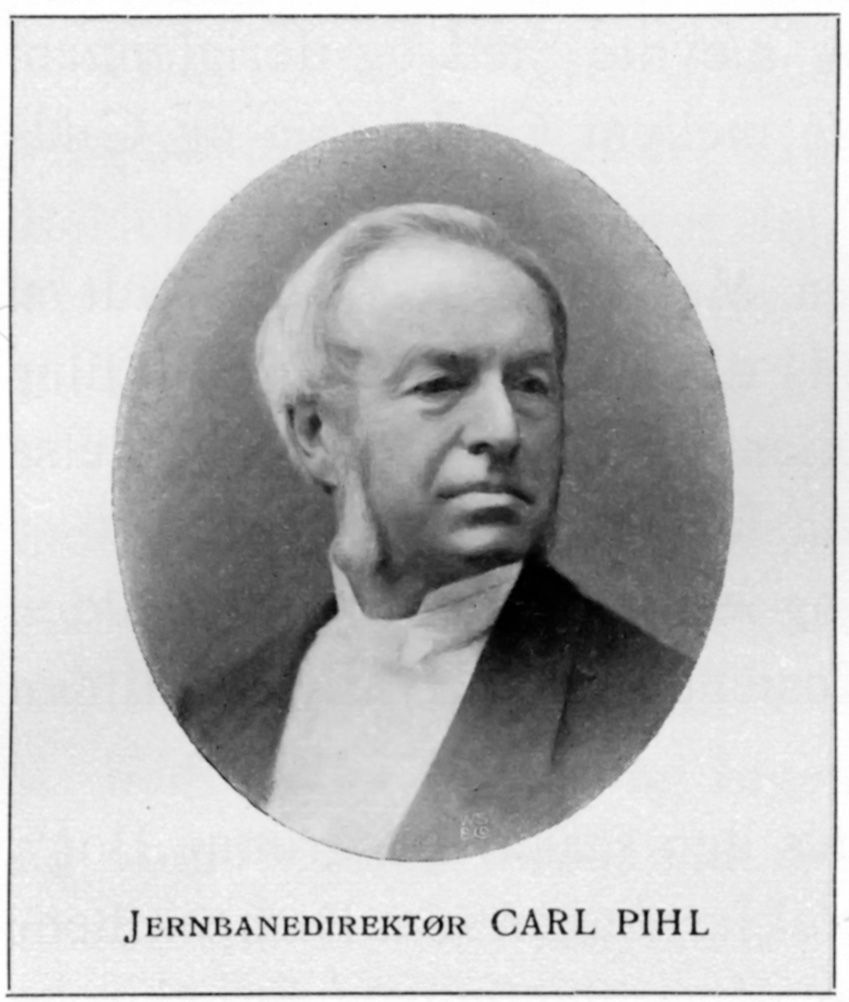- Carl Abraham Pihl
Infobox Person
name = Carl Abraham Pihl
image_size = 181px
caption =
birth_name =
birth_date = birth date and age|1825|01|16
birth_place = Stavanger, Norway
death_date = 1897
death_place =
death_cause =
resting_place =
resting_place_coordinates =
residence =
nationality = Norwegian
other_names =
known_for = Railway pioneer
education =
alma_mater =Chalmers University of Technology
employer =Norwegian State Railways
occupation = Engineer
home_town =
title =
salary =
networth =
height =
weight =
term =
predecessor =
successor =
party =
boards =
religion =
spouse = Cathrine Ridley
partner =
children = 11
parents = Thomas Bugge Pihl
Fredrikke Wivicke Margrethe Løvold
relations =
website =
footnotes =Carl Abraham Pihl (
16 January 1825 ,Stavanger – 1897) was a Norwegiancivil engineer and director of the Norwegian State Railways (NSB) from 1865 until his death. Pihl was one of the main architects behind use ofnarrow gauge railways in Norway.Bjerke and Stenersen, 2002: 9]Biography
The son of Thomas Bugge Pihl and Fredrikke Wivicke Margrethe Løvold, he started off as a
seaman , but soon chose to attendChalmers University of Technology inGothenburg (1841–1844).He then wen toLondon and worked as an office engineer; working on many cases related to railways, including many of those byRobert Stephenson . After two years he started with field work, with a management position at a site inSuffolk until 1850. While working in England he also learned the art of photography. His collections remain a unique collection of Norwegian railway heritage, dating back to 1862.Pihl returned to Norway in 1850, and started working for the road office at
Norwegian Ministry of the Interior , but by 1851 he was hired as an engineer on Norway's first railway,Hoved Line where he worked with the section from Christiania to Lillestrøm. After the completion in 1854 he moved back to England for a year, but returned to work on theTelemark Canal , and later as county engineer inAkershus . Since he was the most prominent railway engineer in Norway at the time, he was in 1856 hired to work on the projections for several of the first railways in Norway, the first being theKongsvinger Line , Hamar–Grundset Line andTrondhjem–Støren Line . In 1858 the office "Statens Jernbaneanlægs hovedkontor" was created to mange the state railways, and Pihl was hired as director. [Bjerke and Stenersen, 2002: 9–10] [Holøs, 1990: 34]After the reorganization of the state railways in 1865 Pihl was appointed the first director-general of the state railways. When this was transformed to the
Norwegian State Railways in 1883, Pihl was appointed director of the fixed-stock division—a position he held until his death. During his last fourteen years he was considerably less influential than previous, but he remained the highest payed civil servant in Norway at the time. He was offered a job in Toronto for theGrand Trunk Railway , but refused despite being offered twice the wage; he even insisted the offer remain confidential so it was not seen as a matter to press up his wage with the Norwegian authorities. [Bjerke and Stenersen, 2002: 12–13]He married Cathrine Ridley, and had 11 children from 1854 to 1875.
Gauge controversy
When Hovedbanen had been built by
Robert Stephenson , he had built the line after British standards withstandard gauge and overdimensioned bridges and curves; this line was very expensive and Pihl felt that it would be possible to build cheaper lines ifnarrow gauge was instead chosen. After studying foreign designs,C. W. Bergh initially concluded with 1016 mm would be suitable, but Pihl argued for some more width and opted for RailGauge|1067. Through his influential position in the department he convinced the politicians that all new railways should be built in narrow gauge—except those that would connect with the Swedish system, where standard gauge had become the norm. During the railway construction boom of the 1870s and 80s all but the Kongsvinger Line, theMeråker Line and theØstfold Line were built as narrow gauge, leaving Norway with two incompatible systems. [Bjerke and Stenersen, 2002: 10]At the time it was not considered probable that the railway system would become connected, but by the turn of the century large-scale projects like the
Bergen Line andSørland Line were connecting all the loose railways;transshipment costs were becoming a drain on resources for the railways and all narrow gauge lines were either closed or converted from 1909 to 1949, at a cost many times larger than the initial savings of building them narrow. During the 1880s the issue of gauge reappeared, with the majority claiming to broad gauge; it was soon shown that standard gauge railways built on the same premises as narrow gauge could be constructed at the same cost. [Bjerke and Stenersen, 2002: 10–13] Pihl commented in his late years that while he realized that narrow gauge had become outdated, at the time it had been a choice between building narrow and cheap, or not building at all. [Bjerke and Stenersen, 2002: 13] The final death of narrow gauge came the year after Pihl died when parliament decided to build the Bergen Line as standard gauge.The narrow gauge developed by Pihl is the only notable rail transport export from Norway; through his international travels he convinced other rural countries to build cheaper narrow gauge systems, and the 1067 mm system soon became one of the major systems in the world—many colonies like
South Africa andNew Zealand opted for the gauge.Bjerke and Stenersen, 2002: 11]References
Notes
Bibliography
*cite book |author=Bjerke, Thor and Stenersen, Roar |year=2002 |title=Rørosbaneboka |publisher=
Norsk Jernbaneklubb /Norsk Jernbanemuseum |location=Hamar |isbn=82-90286-24-4
*cite book |last=Holøs |first=Bjørn |authorlink= |coauthors= |title=Stasjoner i sentrum |year=1990 |publisher=Gyldendal Norsk Forlag |location=Oslo |isbn=82-05-19082-8
*cite book |author=Owen, Roy |year=1996 |title=Norwegian Railways: from Stephenson to high-speed |publisher=Balholm Press |location=Hitchin |isbn=0-9528069-8External links
* [http://www.my-scandinavia.de/articles.asp?ID=2 Norwegian Railroad History] de icon
* [http://www.jrtr.net/jrtr31/f33_sai.html CAP-Spur in Japan (with biographic sketch of Pihl)]
Wikimedia Foundation. 2010.
